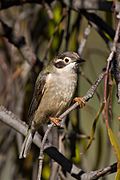Melithreptus facts for kids
Quick facts for kids Melithreptus |
|
|---|---|
 |
|
| White-naped honeyeater (Melithreptus lunatus) | |
| Scientific classification |
|
| Kingdom: | Animalia |
| Phylum: | Chordata |
| Class: | Aves |
| Order: | Passeriformes |
| Family: | Meliphagidae |
| Genus: | Melithreptus Vieillot, 1816 |
The Melithreptus birds are a group of honeyeaters, a type of bird known for eating nectar. These birds are all found in Australia. There are usually seven different kinds, or species, in this group.
Contents
Meet the Melithreptus Honeyeaters
The name Melithreptus was first used by a French bird expert named Louis Jean Pierre Vieillot in 1817. Another expert, William Swainson, later used a different name, Eidopsarus, in 1837. He named one bird Eidopsarus affinis, but another expert, Gould, later described the same bird as Melithreptus melanocephalus.
What Makes Them Special?
Scientists have divided the Melithreptus birds into two main groups, called subgenera: Melithreptus and Eidopsarus. These groups are different based on how they find their food.
Where Do They Live and How Do They Eat?
Birds in the Melithreptus subgenus usually look for insects among the leaves or at the top of trees. They often gather in larger groups and live in open, dry forests. These birds also have smaller feet.
On the other hand, birds in the Eidopsarus subgenus find insects by poking into the bark of tree trunks and branches. They prefer eucalypt forests and rainforests. These birds usually travel in small family groups. They have stronger legs and feet, which helps them climb on tree trunks.
A biologist named Allen Keast studied these birds across Australia. He noticed that in many places, you could find one bird from each group living together. The birds that ate from tree trunks were usually about 10% bigger than the ones that ate from leaves. For example, the smaller White-naped honeyeater (Melithreptus lunatus) is often found with the larger Black-chinned honeyeater (Melithreptus gularis).
Their Family Tree
Scientists have looked at the genes of these birds to understand their family history. They found that the Melithreptus group separated from the ancestors of the blue-faced honeyeater a long time ago, between 12.8 and 6.4 million years ago. The blue-faced honeyeater is much bigger, has brighter feathers, and is more social than the Melithreptus birds.
The white-throated honeyeater became its own species between 9 and 5 million years ago. The strong-billed honeyeater also separated from other Eidopsarus birds between 6.7 and 3.4 million years ago.
Different Kinds of Melithreptus
For a long time, people thought there were six main species of Melithreptus. But in 2010, new information showed that Gilbert's honeyeater is its own distinct species. Also, the golden-backed honeyeater, found in northern Australia, used to be considered a separate species. However, it often mixes with the black-chinned honeyeater, so now it's seen as a type of black-chinned honeyeater.
Species List
| Subgenus | Image | Common name | Scientific name | Distribution |
|---|---|---|---|---|
| Melithreptus |  |
Black-headed honeyeater | Melithreptus affinis | Tasmania |
 |
White-naped honeyeater | Melithreptus lunatus | eastern Australia | |
 |
Gilbert's honeyeater | Melithreptus chloropsis | Western Australia | |
 |
White-throated honeyeater | Melithreptus albogularis | New Guinea and eastern and northern Australia. | |
| Eidopsarus |  |
Brown-headed honeyeater | Melithreptus brevirostris | Australia. |
 |
Black-chinned honeyeater | Melithreptus gularis | Australia | |
 |
Strong-billed honeyeater | Melithreptus validirostris | Tasmania |
See also
 In Spanish: Melithreptus para niños
In Spanish: Melithreptus para niños

